Saturday, May 21st, 2011
Mondrian’s Evolution
A few months ago, my husband and I were looking at an exhibition of photographs by Arnold Newman. This series depicted portraits of different 20th century artists, and it was so interesting to see a compilation of faces that are figuratively “behind” the great works of art from that era. I particularly remember a photograph of Mondrian. Upon seeing that photograph, my husband laughed and said (all in good humor), “Ha! This looks like an uptight guy who would paint grids and squares!”
I’ve been thinking about that comment this afternoon, as I’ve been looking at Mondrian’s oeuvre. Mondrian is definitely best known for the De Stijl movement and paintings from his mature style (such as his Composition in Yellow, Blue and Red, 1937-42, shown left).
Although I like Mondrian’s mature style well enough, I agree with Rosalind Krauss that Mondrian limited himself (or caged himself!) within with the grid composition of his mature style.1 Mondrian painted in this style from about 1920 until the he died from pneumonia in 1944.
Personally, I am much more drawn to Mondrian’s pre-1920 paintings. I sense more freedom and exploration in these earlier works, which appeals to me more than the formulaic (but undoubtedly iconic) later style. I also find it interesting that Mondrian took an early interest in depicting the natural world, but he gradually moved toward abstraction after the introduction of Cubism. Honestly, I think Greenberg could have created a little “Modernist Painting” trajectory on Mondrian’s career: Mondrian continually flattens his paintings and removes “non-art” references until finally reaching his mature style.2
Here is just a glimpse at how Mondrian’s style changed over the beginning of his career:
So, I guess that Mondrian wasn’t always the “uptight guy” who favored squares and primary colors! What do you prefer? Mondrian’s earlier style or his mature style? Why?
1 Rosalind Krauss, “The Originality of the Avant-Garde: A Postmodern Repetition,” October 18 (1981): 56.
2 See Clement Greenberg, “Modernist Painting,” in Art in Theory 1900-2000: An Anthology of Changing Ideas by Charles Harrison and Paul Wood, eds. (Oxford: Blackwell Publishing, 2003), 773-779. Essay first published in 1960.
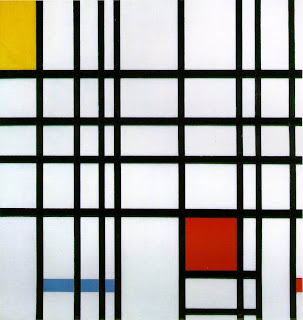
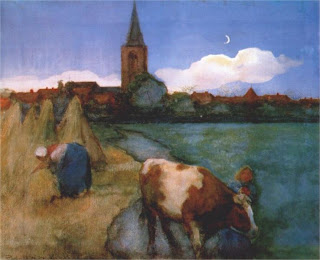



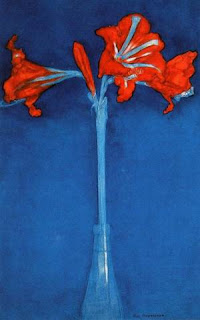
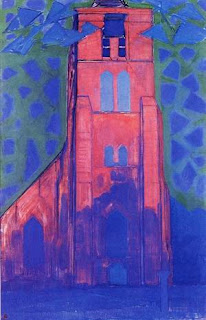

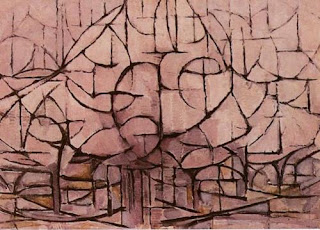
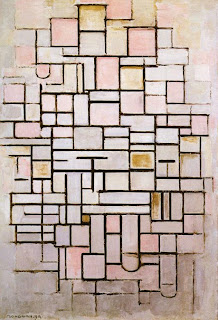


Fascinating post M!
I have always been very fond of the mature style of Mondrian – the influence of his work in design and popular culture is highly prevalent. I've see his grid designs in clothes, furniture, shoes – even the cover of the White Stripes album, appropriately called De Stilj.
Though my favourite reference to it would have to be a painting reproduced and admired by the android character 'Data' in Star Trek The Next Generation as he sought to explore his creative side.
It's interesting to note the progression of Mondrian's style over time, his compositions seem to deconstruct into line and colour.
Rather than saying he was 'caged' by it, it would be interesting to explore what was happening with him in a psychological and social sense – do any details in his biography shed any light on this development?
One doesn't just go from landscapes and figures to grids just for the fun of it…surely?
Kind Regards
H
Hmmm, maybe someone needs to do their dissertation on Mondrian's early work? *wink wink wink*
I liked every paintings, but I think yor right: his earlier paintings seem more free than the last ones. I specially liked the flower, which I didn't know.
I'm reminded of the well known Ad Reinhardt cartoon:
http://tinyurl.com/3hyl7en
Thanks for the comments!
H Niyazi: No doubt that other art historians have analyzed Mondrian's paintings in relation to his biography. I'm sure I'm not the first to think this, but I have sometimes wondered if Mondrian's mature style was in response to the chaos after WWI. Perhaps the calculated, orderly geometric forms were appealing after Europe experienced so much devastation.
I also have been wondering lately if Mondrian's mature style was a calculated move in order to make his name/style more marketable. My husband is currently reading a biography on Mark Rothko (by James E. B. Breslin), and Rothko mentioned how he conscientiously switched to the rectangle format because it was more "iconic." Perhaps Mondrian also wanted to establish his identity as a painter with such an iconic style and approach?
heidenkind: Ha ha! I don't love Mondrian enough to dedicate a decade of my life to studying him! But his early style is interesting to me.
Margarida Elias: Isn't that flower painting beautiful? It is one of my favorites.
Ben: I hadn't seen that cartoon before! Ha ha! I'll have to show that to my students, the next time I teach about Mondrian.
I know nothing about Mondrian, but have always loved his grid paintings. This series of paintings might explain why. Is it just me, or do they show an extraordinary exploration of portraying depth? I mean, isn't that what's coolest about the late paintings: that they pretend to be two dimensional when they dramatically represent three?
This post made my day, btw!
M you are famous! After waking up from accidentally falling asleep in my chair at work (I have not been sleeping well) I went to reader to see what could be had.
Collin's brother Justin posted this post on his reader because his wife really loves Mondrian.
Also, did I ever mention how my painting professor, the crazy one, loves Mondrian and was always talking about how he died relatively unknown, poor and only ever sold one painting his entire life…hmmm do you mean Van Gogh?
hcr: Thanks for your comment! Looking at his scope of paintings, I think one could make the argument that Mondrian's mature style appears to be abstraction of three-dimensional space (instead of being non-representational).
Though, to be fair, I should say that Mondrian felt like he was moving away from nature (and therefore space) in his later work. Right before his mature style began, Mondrian published an essay in 1919. The essay was comprised of an imaginary discussion between two people. Here is an excerpt:
"Person A: But didn't your earlier work represent nature?
Person B (the painter): I expressed myself by means of nature. But if you carefully observe the sequence of my work, you will see that it progressively abandoned the naturalistic appearance of things and increasingly emphasized the [material] expression of relationships." (See Piet Mondrian, "Dialogue on the New Plastic" in Art in Theory 1900-2000, p. 284).
So, it seems that in Mondrian's mind, he moved away from representing nature (and therefore space) and focused more on the relationships between what he calls "plastic" elements (or "material" aspects of art, like color and line).
phin: Buddy! Thanks for your comment. I wonder how Collin's brother came across my blog (did you give him the URL?). I'm glad that he liked the post.
Your painting teacher cracks me up. You should ask your teacher if Mondrian cut off his own ear, too.
so interesting! i like his "middle" years – that 1911-12 still life is my style. 🙂 great post! MUST read up on him…if my kids will give me some peace…
His earlier works could be mistaken for Monet, Van Gogh, Klimt, Braque – no wonder he strove to develop a style that defined him, and only him.
I can see how his later works expressed relationships, but it seems very limiting without using curved lines. Yet I suppose that "cleanness" is what is so attractive in his work.